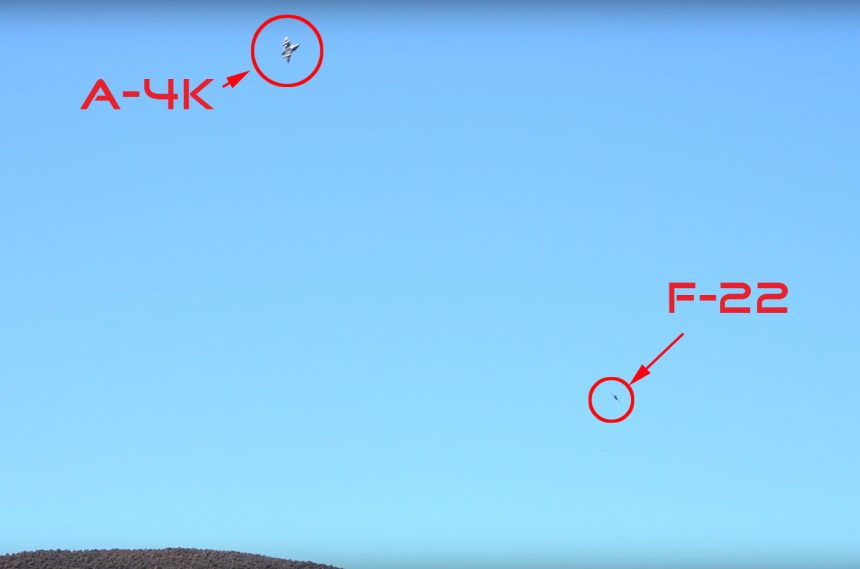Top Gun Reloaded featuring F-22 Raptor and A-4 Skyhawk.
I’m pretty sure most of you remember the Top Gun movie scenes with the F-14 Tomcats dogfighting with A-4 Skyhawks around mountains. Those scenes were shot around NAS Fallon, Nevada, not too far from where the footage below has been filmed some 30 years later.
The footage shows a U.S. Air Force F-22 Raptor engaging with an A-4K Skyhawk in the Nellis Test and Training Range. The Skyhawk is one of the jets belonging to Draken International, a company that supports military training around the globe with a fleet of 80 tactical fighter aircraft. The extensively upgraded in the early 1990s to a standard similar to the F-16 Mid-Life-Update with a 1553 digital bus, APG-66v7 radar, RWR (Radar Warning Receiver), HOTAS (Hands On Throttle And Stick) controls, HUD (Head Up Display) and MFDs (Multi-Function Displays). In other words, although not the most advanced Aggressors around, at least what’s needed to perform the adversary role against 4th and 5th generation combat planes.
As explained by an F-35 pilot last year, dogfighting against the A-4 is still relevant today for several reasons:
- The F-35’s sensors and “fusion” provides me as a pilot with good situational awareness. For an F-35 to simulate an opponent against another F-35, it has to restrict the effects of fusion and the various sensors. Even then it is difficult to “dumb down” the aircraft enough. It requires discipline to not be tempted to using information that an opponent in reality would not have access to.
- The A-4s we faced in these exercises had sensor performance along the lines of our own upgraded F-16s. They also carried jammers intended to disturb our radar.
- The pilots we faced were very experienced. We are talking 2000 hours plus in aircraft like the F-16, F-15E, F-15C and the F-22, with detailed knowledge of “fifth generation” tactics and weapons. When also cooperating closely with intercept controllers on the ground (GCI) they could adapt the training and offer us a reactive and challenging opponent. Note the word “reactive.”
- The A-4 is a small aircraft with a corresponding signature. Many potential opponents in the air are bigger and easier to find than the tiny A-4.
Anyway, dealing with the video, as our friend Tyler Rogoway suggested when commenting the very same video in his article at The War Zone: “It’s not entirely clear if one Raptor was orbiting waiting as another F-22 drove the fleeing A-4 towards his wingman—a classic predatory trap—or just one F-22 was present and it waited for the Skyhawk to come into range before dropping behind him and killing him.”
Update: we have collected more details about the sortie. First of all, it was a WSI (Weapons School Integration) mission. The F-22 was part of a package made by 4x F-22s and 4x F-15s doing CAP (Combat Air Patrol) and clearing the airspace for the strikers to enter. There were 2x A-4s (one not in the frame) and the F-22 descended all the way from 40,000 feet to engage the 2 low A-4s!
If you look closely at around 00:27 seconds, you can see the F-22 side weapons bay briefly opening and closing: the Raptor’s side bay door houses the canted trapeze that the F-22 Raptors use to eject the missile into the airstream. Not sure the reason why they were opened during this engagement.
The Raptor’s side weapons bay is used to carry the AIM-9X, the Sidewinder variant integrated on Mar. 1, 2016, when the 90th Fighter Squadron (FS) belonging to the 3rd Wing stationed at Joint Base Elmendorf-Richardson, Alaska officially became the first combat-operational Raptor unit to equip an F-22 with the latest variant of the IR-guided missile.
As explained several times here, most of the modern US combat planes use the AIM-9X along with a Helmet Mounted Display since 2003: with a HMD (like the American Joint Helmet Mounted Cueing System – JHMCS), information imagery (including aircraft’s airspeed, altitude, weapons status, aiming etc) are projected on the visor enabling the pilot to look out in any direction with all the required data always in his field of vision. The HMD enables the pilot to exploit the full HOBS (High Off-Boresight) capabilities of the AIM-9X and engage a target by simply looking at it.
However the AIM-9X will not be coupled to a HMD as the Raptor is not equipped with such kind of helmet that provides the essential flight and weapon aiming information through line of sight imagery. In 2019, the Air Force plans to equip the F-22 with the AIM-9X Block II, the F-22 will probably fill the gap as the most advanced variant of the Sidewinder is expected to feature a Lock-on After Launch capability with a datalink, for Helmetless High Off-Boresight (HHOBS) at intermediate range: the air-to-air missile will be launched first and then directed to its target afterwards even though it is behind the launching aircraft.
Top image: screenshot from the video by 8081rt








